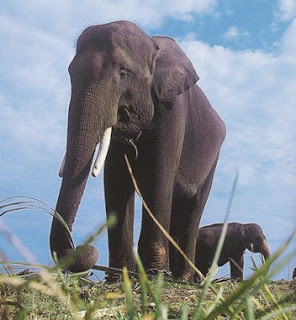Way Kambas National Park (WKNP) is undoubtedly one of the prime tourist attractions to be found in Lampung, a province that sits on the southernmost tip of Sumatra. As well as having the area's most famous attraction, namely its elephant school, the Way Kambas National Park also houses the way Kanan Resort, The Sumatran Rhino Santuary (SRS) and the Elephant Conservation Center (ECC), all of which are equally unique and well worth the visit in their own right.
Beast such as Torgamba, a resident 31-year-old male rhinoceros who have been living at the Sumatran Rhino Sanctuary since 1998 and who has brought to Indonesia from a British Zoo, also give the park character. The Sumatran rhino is a notoriously slow breeder and the Sumatran Rhino Sanctuary has, until now, been able to birth any calves. Ratu, a female rhino living at the sanctuary, recently tested positive in several pregnancy tests, however it remains to be seen if she'll carry her offspring to full term.
Located in the Regency of East Lampung, Way Kambas National Park spans an area of 130,000 hectares and was officially designated a National Park in 1989. Today, Way Kambas National Park has become synonymous with its elephant school. At the Way Kambas Elephant Training Center (ETC), the animal that is often seen as a pest and a mortal enemy by farmers is "schooled" to become lovable creature that is amusing, gentle, and good natured. The elephant are also trained to perform circus-like acrobatic stunts and tricks, and even to dance to the beat of Indonesian dangdut music.
The Elephant Training Center is located about 112 kilometers from the City of Bandar Lampung. Covering an area of about 130,000 hectares, The Elephant Training Center is not only inhabitants by Sumatrans Elephants, but is also the habitat of the Sumatran Rhino, as well as several other protected animals. The Way Kambas National Park reaches its peak, in terms of visitor numbers, during the summers months of July through to September.
The Elephant Training Center has trained and produced hundreds of wild elephants, which are now use as transportation and to do heavy work. Many have also become tourists attractions, and some now live in amusement parks in various cities around the country, such as Ragunan Zoo In Jakarta, and the Borobudur Temple Tourism Park in Central Java. Uniquely, the elephant students at the Elephant Training Center Way Kambas have been given the commonly used names of their human counterparts; namely Kartijah, Karnaningin, Kartini, Haryono, Rizka and others, so do not take offence if you find that you share a name with an elephant.
The elephant students are taught incredible tricks at the Elephant Training Center, such as shaking hand, playing soccer, saluting, draping flowers, tug-of-war, and dancing to music. If you possess nerves of steel, than you can also try your hand at one of the center's most thrilling attractions;namely having trained elephant employ great precision to weave over and around you as you lie still on the ground.
A less extreme adventure can be had by riding on an elephant as it lumbers along well beaten paths and around swamps for half an hour of a full hour. You'll feel like a maharaja from a bygone era. You can also live out your Hannibal fantasies by enjoying the experience of riding an elephant on a wild jungle safari. There's even an elephant night safari, which is no less spectacular.
The Way Kambas National Park is also a great camping spot from which tent heads can explore the local natural splendour. At first glance the park, with its vast grass fields, seems to resemble a savannah. In some places around the park, elephant whose feet are chained can be seen. These are a wild elephants in process of being trained. The Way Kanan Forest is also worth checking out, and its typical lowland forest ecosystem consisting of fresh water swamp forests, grassland, bushes and coastal forests. As one of the richest ecosystem in Indonesia, The Way Kambas National Park possesses a vast variety of flora and fauna species. Plant species in the park included api-api (Avicenia marina) and many others. The park also contains about 50 species of mammals, many of them critically endangered species, including the Sumatran rhino, the Sumatran elephant, the Sumatran tiger, honey bears and red monkeys.
No visit to Way Kambas is complete without a trip to the Way Kanan Resort. This spot also houses research and breeding centers for the Sumatran rhino and the Sumatran tiger, which come complete with laboratory facilities and dormitories for researches.
It is at the Way Kanan resort that the aforementioned Sumatran rhino Sanctuary is situated. The Sumatran rhino Sanctuary plays a vital role in the conservation of the slow-breeding Sumatran rhinoceros, albeit one that is often inhibited by the very nature of the species that the sanctuary is trying to preserve. It is estimated that there are currently only around 200 wild rhinos spread across the forests of Sumatra and Kalimantan. Within the sanctuary itself meanwhile, there are currently only five captive rhinos that roam a 100-hectare plot which is surrounded by an electric fence.
Despite decreasing populations, the park is also still home to a few critically endangered Sumatran tigers. Their number have fallen dangerously low over the past five years. Park rangers estimate the current number of tiger living in the 125,000 hectare national park to be less than 30, compare to estimates of between 36 and 40 tigers in 2000.
Like their rhino counterparts, Sumatran tigers also reproduce at a very slow rate, and serious poaching by animal traders and deforestation as a result of illegal logging. To date, the park has implemented several measures designed to prevent poaching. This include increased patrols and CCTV surveillance, as well as increasing the number of rangers in the park, however, these initiatives are easily eclipsed by the insatiable demand for timber and exotic taxidermy.
Sad extinction battles aside however, the Way Kambas National Park is a stunningly beautiful place in which to enjoy outdoor activities such as bird-watching (the rare white winged wood duck is just one of over 400 species that can be found in the park), backpacking, trekking, camping, photo hunting, and if one is lucky, stumbling across some truly rare animals and plants. Visitors can also traverse the fringes of rivers such as the Way Kanan, Rawa Gajah, and Kuala Kambas, and observe water loving forest animals such as ducks, egrets, deer, and migratory birds. Grassland and mangrove forests complete the biodiversity fiesta. Truly a natural paradise.
How to get there
Garuda Indonesia Airways flies Jakarta-Bandar Lampung 35 times per week. To reach Way Kambas National Park, you can take a taxi or rent a car from Raden Inten AIrport. The park is located about 112 kilometers from the city of Bandar Lampung.
skip to main |
skip to sidebar

Natural features and ecology, including plants and animals, scientific interest, recreational and educational value of great beauty.
Stories
Activities
Buffer Zone
Creativity
Ecology
Environment
Familiar Food for Medicine
Flora
Fruit and Vegetable Juices for Healing
Garden
Health Problems
Horizontal Lines
Indonesia National Park
Kerak Telor
National Park Photo's
People
Pollution
Seven Wonders Of Indonesia
The City
The Tribe
Tourism
Transportation
Travel Note
Popular Posts
-
Botanical Garden A botanical garden is an area in which plants are grown primarily for scientific study or for viewing by...
-
Knowledge about traditional medicines in Indonesia is quite extensive because of the great diversity in local cultures. Unlike Chinese tradi...
-
Skin of fruits or vegetables are not as fruits itself. The skin of fruits or vegetables may taste bitter, acidic, or in bad taste, people ...
Blog Archive
Followers
About Me

- Renren Rendra Megantara
- Bandung, West Java, Indonesia
- Learning is the key to make your brain healthy, fresh and always useful for any conditions of life
Powered by Blogger.
Copyright (c) 2010 Related Of Environment (ROE). Design by FreeCssTemplates
Themes By Buy My Themes And Top VPS Hosting.





0 comments:
Post a Comment